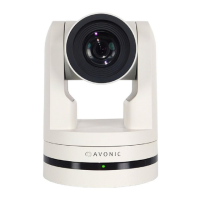Prenez note que les couleurs des fils peuvent être différentes dans votre câble audio selon les photos
(connecteur XLR et Phoenix) ci-dessous. Vous devez savoir lesquels sont les canaux droit et gauche et lequel
est le GND (masse).
Picture 1: XLR connector Picture 2: Phoenix connector
Connecting a Controller to a Camera
You can connect one or more cameras to a VISCA (serial) controller.
See https://avonic.com/en/product-categorie/controllers/ for an overview of the available controllers.
A controller gives you direct control over the most important camera settings (e.g., Pan, Tilt, Zoom, Focus, White
Balance). You can access all other settings through the OSD Menu of the camera using the controller.
Connecting the camera to a local network
The camera can be connected via a serial connection to USB, HDMI, SDI, RS-232, RS-485, or via a LAN Ethernet
connection. Each of these options is outlined below.
Connecting via USB, HDMI or SDI
Execute the following steps to connect the camera to a desktop or a (computer) monitor via USB, HDMI
or SDI:
1. Connect the camera to the desktop or monitor via the USB, HDMI or SDI port (see figure above).
2. Open the Windows Camera app or a third-party camera app.
3. Open the Settings.
4. Select the camera you just connected, or click on the option / icon to change the camera to the
camera you just connected.
5. Press the MENU button on the provided IR Remote Control to open the OSD Menu.
See Using the Remote Control for more information on how to use the Remote Control.
Serial Connecting via RS-232 or RS-485
COM Port Settings
In default working mode, the camera can connect to a VISCA controller via an RS-232 or RS-485 serial interface.
The applicable COM port settings are (where '*' stands for 'Default value'):
21

